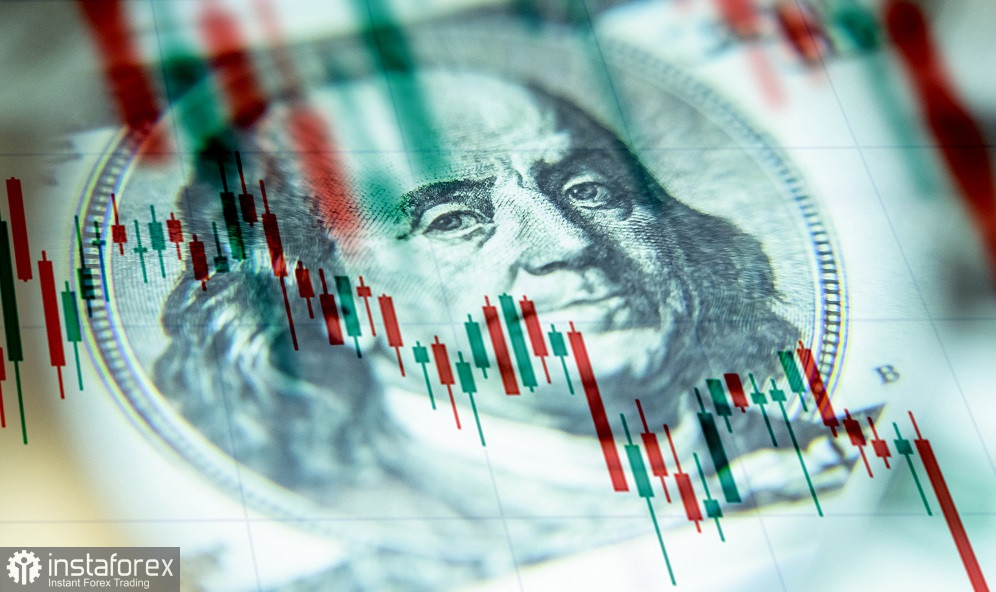The U.S. dollar index continues to plummet ahead of the inflation release and amid improved risk sentiment. The yield on benchmark 10-year Treasury bonds sharply declined to the current level of 3.96%, following a similarly sharp surge to 4.06% (the highest level since October of last year). Meanwhile, the euro-dollar pair is testing the 1.10 level, reaching a two-month high at 1.1027. Although buyers are struggling to push higher, bullish sentiment clearly prevails for the pair. Note that such price dynamics are solely due to the weakening of the greenback. If we look at the major euro cross pairs, we can see that the single currency is not in the best shape. Therefore, if the dollar strengthens following the upcoming inflation releases, the euro will not be able to hold its ground and will follow the quoted currency.

However, according to preliminary forecasts, the dollar is unlikely to find support from macroeconomic data. In fact, the current decline in the dollar index is attributed to yesterday's release, which served as a "warning bell" ahead of the publication of key data. The monthly consumer expectations survey by the Federal Reserve Bank of New York showed that inflation expectations among American consumers for the next year plummeted in June to the lowest level since April 2021, at 3.8% (compared to 4.1% in the previous month).
In essence, this report is of secondary importance; under different circumstances, the market would simply ignore this release. However, traders of dollar pairs are currently highly sensitive, reacting sharply to any signals that reduce the likelihood of another interest rate hike by the Federal Reserve following the increase in July. A striking example in this regard is the June Nonfarm Payrolls, which were overall quite good but not "breakthrough," if we may put it that way. The unemployment rate in the U.S. decreased to 3.6%, wage indicators remained at the May level (contrary to forecasts of a decline), and the indicator of nonfarm employment growth increased by 209,000. However, this was not enough to strengthen the American currency. The release once again confirmed the rate hike in July but did not alter expectations for September.
Heightened expectations are also placed on inflation reports. This primarily applies to the report on consumer price index (CPI) growth, which will be published tomorrow, July 12. According to the majority of analysts, the June CPI will reflect a slowdown in inflation growth in the U.S. Specifically, the overall consumer price index in June is expected to decline sharply to 3.1% year-on-year (compared to the previous value of 4.0%). The core index, excluding food and energy prices, is also expected to demonstrate a downward trend, slowing down from May's 5.3% to 5.0% year-on-year.
The other inflation reports that will be published this week should also reflect a slowdown in inflation in the United States. For example, the producer price index is expected to sharply decline to 0.4% year-on-year, which is the weakest result since August 2020. The core producer price index should demonstrate a similar trend, decreasing to 2.7% year-on-year (compared to the previous value of 2.8%). In this case, it will be the fifteenth consecutive decline in the indicator.
If the aforementioned reports meet at least the forecast level, the greenback will come under downward pressure. But if the data turns red, the U.S. dollar index may hit multi-month lows, dropping towards the 100 level. Major dollar pairs will adjust their configuration accordingly.
Ahead of these events, EUR/USD buyers are trying to build on their success, clinging to the 1.10 level. Each upward move is difficult, as the upward dynamics are solely due to the weakening of the greenback. In this case, the euro serves as ballast, especially against the backdrop of today's ZEW economic sentiment data.
Almost all components of the release turned out to be in the "red zone," putting pressure on the euro. For example, the German business sentiment index declined sharply to -14.7 points, compared to a forecast decline to -10 points, marking the weakest result since December 2022. The Eurozone's business sentiment index also entered the "red zone," falling to -12 points, compared to a forecast decline to -10 points (the lowest value since December of last year). In other words, ZEW economic sentiment indicators are sinking more noticeably into the negative territory, with the indices remaining below the zero level for the third consecutive month.
Nevertheless, despite this "blow" from the ZEW institute, the EUR/USD pair is holding above the 1.10 target, indicating the weakness of the U.S. dollar.
Can long positions be considered in such conditions? In my opinion, no. The prospects for further price growth depend solely on the "health" of the greenback, while tomorrow's report can either "sink" the dollar or provide support (if it unexpectedly falls in the green zone). Figuratively speaking, the euro will not be able to "catch the falling flag" in the event of a strengthening U.S. currency. In such an uncertain situation, it is advisable to stay out of the market—at least until the start of the U.S. session on Wednesday, when the impactful report will be released.





















